
MAIA WV – the multispectral camera
MAIA is the multispectral camera that permits the simultaneous acquisition of high resolution images at various wavelenght intervals in VIS/NIR electromagnetic spectrum regions. It is designed to be employed on board the UAV systems or on board aircrafts, and it finds several applications on board terrestrial rovers too, for precision agriculture, classification of crops, classification of materials on soil, environmental monitoring, dumps monitoring.
MAIA WV is the multispectral camera equipped with the same wavelenght intervals of the DigitalGlobe WorldView-2™ satellite.
WorldView-2™ is a commercial Earth observation satellite owned by DigitalGlobe. WorldView-2 provides eight-band multispectral imagery with 1.84 m resolution, in support of services such as agriculture, forest monitoring, land cover changes and natural disaster management.
Now, you can compare satellite data with high-resolution maps obtained through a multispectral survey conducted with MAIA WV, the proper instrument for your multispectral survey.
MAIA is entirely developed in Italy by SAL Engineering, Eoptis and Fondazione Bruno Kessler.
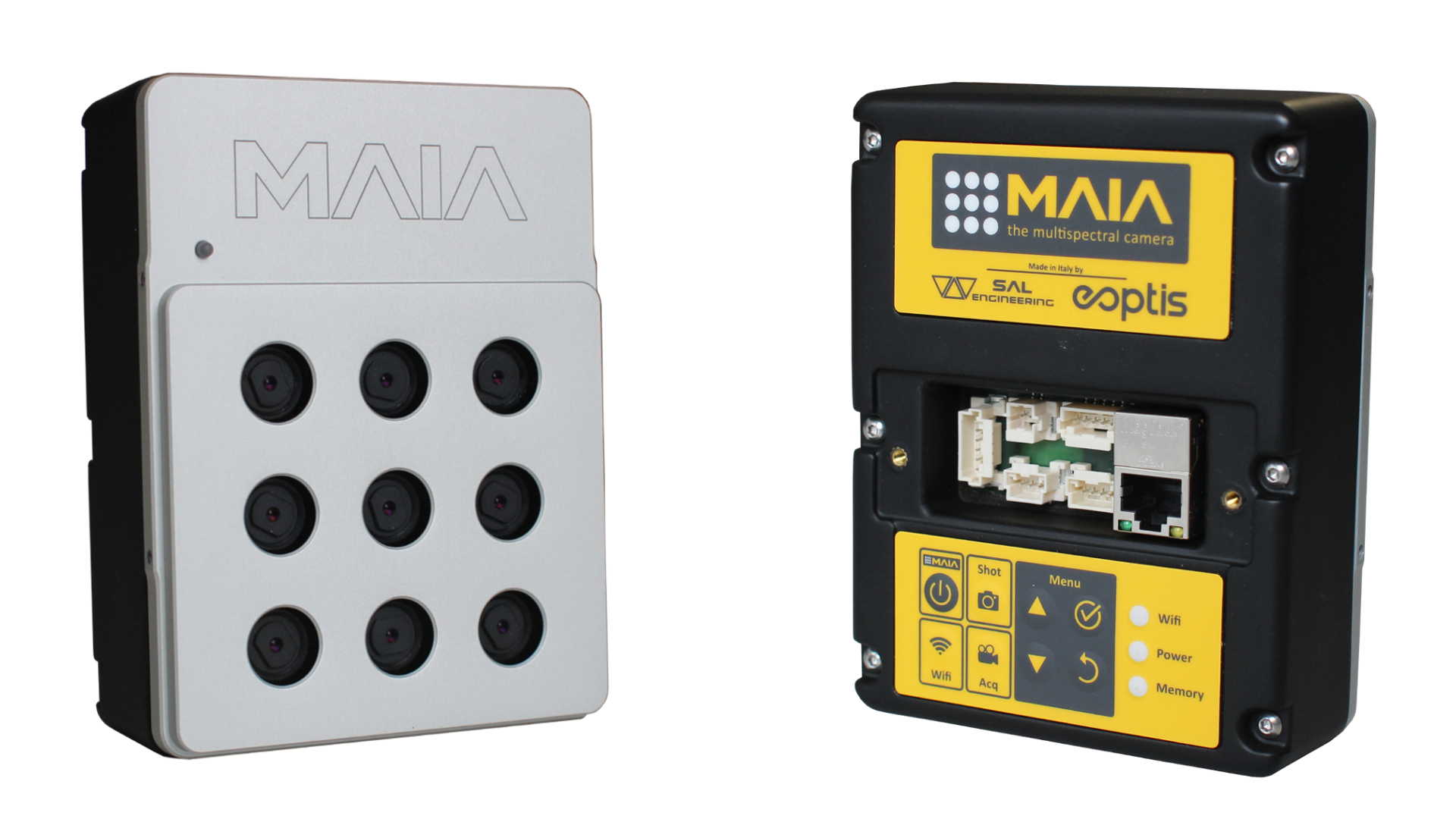
MAIA WV is based on an array of 9 sensors (1 RGB and 8 monochrome with relative band-pass filters) to detect multispectral imagery in the VIS-NIR spectrum from 390 nm to 950 nm. MAIA WV is the most advanced broadband multispectral camera fro RPAS, aircrafts, terrestrial rovers available today, with bands in Coastal and Blue spectrum region.
MAIA WV 13 500 € VAT excl.
Architecture and interfaces
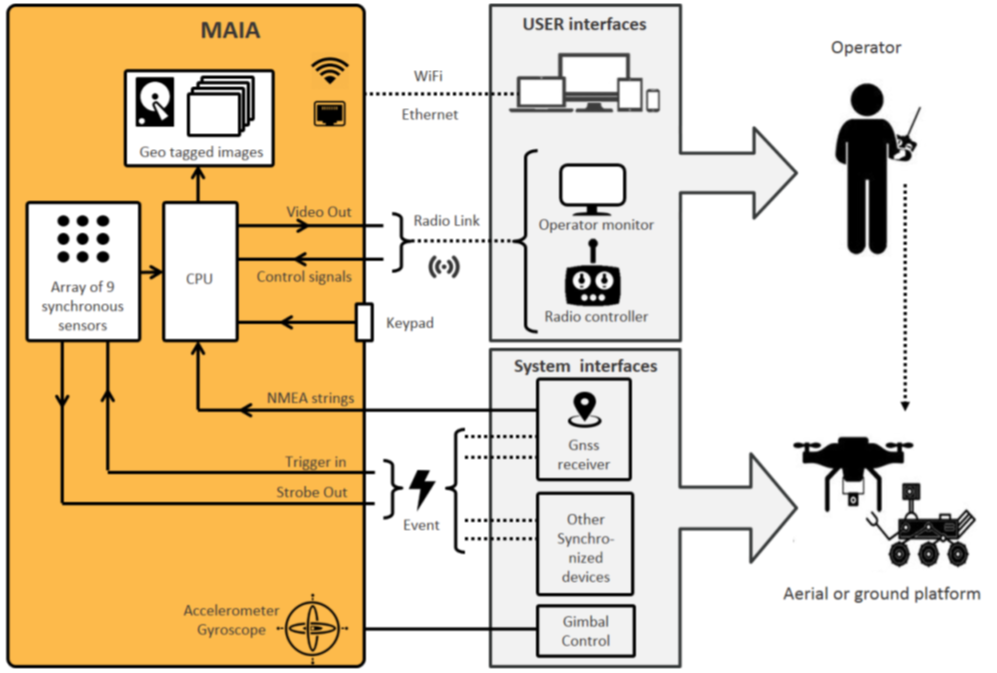
Applications of multispectral survey
Main applications of the multispectral survey conducted with MAIA concern the following fields of interest:
Agriculture and terrain survey
| Geology
|
Industry
| Environmental monitoring
|
Optics
CMOS sensors settled in MAIA have resolution of 1.2 Mpixel each, and present excellent characteristics in terms of sensitivity.
Each sensor is global shutter and shoot simultaneously: it follows that it is not necessary to stabilize the shot with gimbal, which is indispensable with roling shutter sensors to avoid distorsions, crawling and blurring pixels in the images.
The high quality and the radiometric validity of data obtained with MAIA are then guaranteed even during high speed flghts.
Thanks to a web panel easily accessible through Wifi and Ethernet, MAIA permits a fine regulation of all parameters concerning the acquisition activities, from exposure time of each sensor to shot frequency. Automatic configurations are available for standard operations.
Each camera is designed to have a series of specific band-pass filters but, on request, it can be equipped with customized filters. Main filter-set are those related to MAIA WV and MAIA S2.
MAIA WV is based on an array of 9 sensors with the following characteristics:
- 1 RGB sensor (RBG Bayer pattern)
- 8 mono-chromatic sensor with sensitivity in VIS-NIR range from 390 nm to 950 nm
Each sensor has 1280x960 pixels and the dimension of each pixel is 3.75 μm x 3.75 μm.
Mono-chromatic sensors are matched with a bandpass filter based on the intervals as follows:
| Sensor | Start WL(nm) | Stop WL (nm) | CWL (nm) | FWHM (nm) | Color |
| S1 | 395 | 450 | 422.5 | 55 | PURPLE |
| S2 | 455 | 520 | 487.5 | 65 | BLUE |
| S3 | 525 | 575 | 550 | 50 | GREEN |
| S4 | 580 | 625 | 602.5 | 45 | ORANGE |
| S5 | 630 | 690 | 660 | 60 | RED |
| S6 | 705 | 745 | 725 | 40 | RED EDGE |
| S7 | 750 | 820 | 785 | 70 | NIR 1 |
| S8 | 825 | 950 | 887.5 | 125 | NIR 2 |
| S9 | - | - | - | - | RGB |
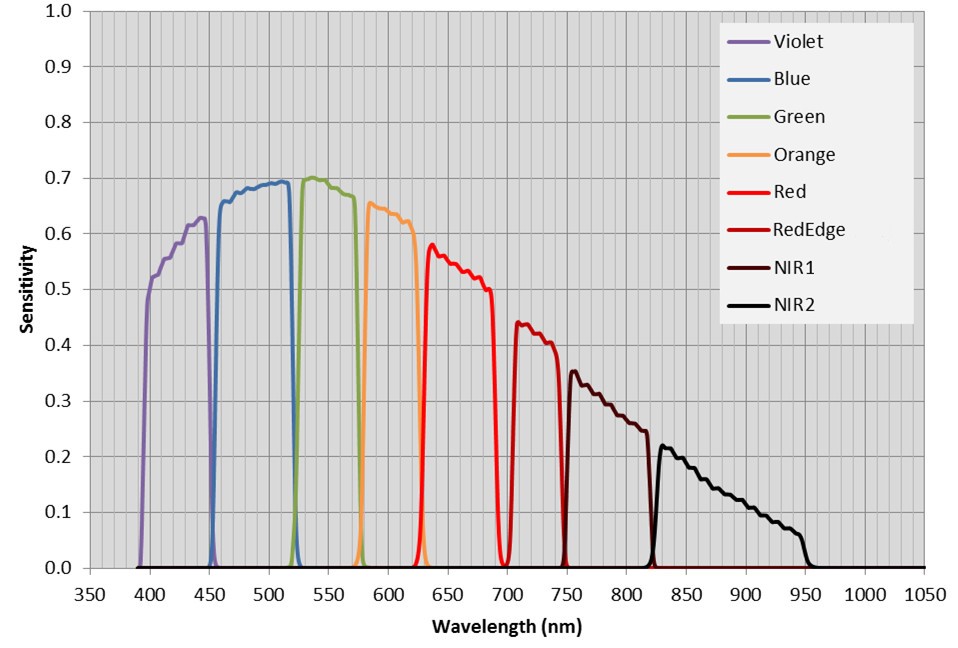
Each sensor has fixed focus lens with the following characteristics:
- Nominal focal lenght: 7.5 mm
- Aperture f/#2.8
- FOV 35° HFOV; 26° VFOV 43° DFOV
Lens are adjusted with focus in laboratory, with no possibility of intervention by the user.
Each optics of every produced MAIA is calibrated in laboratory and for each camera the Calibration Certificate is available, with the following parameters:
- calibrated Focal Length
- position of Principal Point
- distortion lens parameters
Calibration and certificate is carried out by 3DOM group - 3D Optical Metrology of FBK - Fondazione Bruno Kessler in their laboratories.
For the survey operations, the Ground Sample Distance (GSD) and the Field of View (FOV), depending on the Altitude above Ground Level (AGL), are shown in the following table, that also shows the available max speed of the aircraft to acquire images with no motion blur, considering an acceptable pixel blurring and crawling lower than the size of the pixel. The maximum speed of the aircraft depends on images overlap and on shot frequency.
| AGL (m) | GSD (mm/pixel) | FOV (m2) | Max UAV speed with 10 ms exposure time (m/s) – (km/h) | Max UAV speed with 1 ms exposure time (m/s) – (km/h) |
| 50 | 23 | 30 x 23 | 2.3 – 8.4 | 23 – 84 |
| 75 | 35 | 45 x 34 | 3.5 – 12.7 | 35 – 127 |
| 100 | 47 | 60 x 45 | 4.7 – 16.9 | 47 – 169 |
| 150 | 70 | 90 x 68 | 7.0 – 25.3 | 70 – 253 |
| 200 | 94 | 120 x 90 | 9.4 – 33.8 | 94 – 338 |
| 300 | 141 | 180 x 135 | 14.1 – 50.6 | 141 – 506 |
| 400 | 188 | 240 x 180 | 18.8 – 67.5 | 188 – 675 |
Devices and connectors
Via Wifi or via GigaEthernet port, users can interface with MAIA WV to configure parameters, to visualize in real-time images during the acquisition and to download the already saved ones. For these purposes there are several interfaces: a keyboard, a powerful web panel, two inputs for radiolink receivers.
Web access is available both through a high-speed GigaEthernet connection, and through Wifi connection for operation directly on the field.
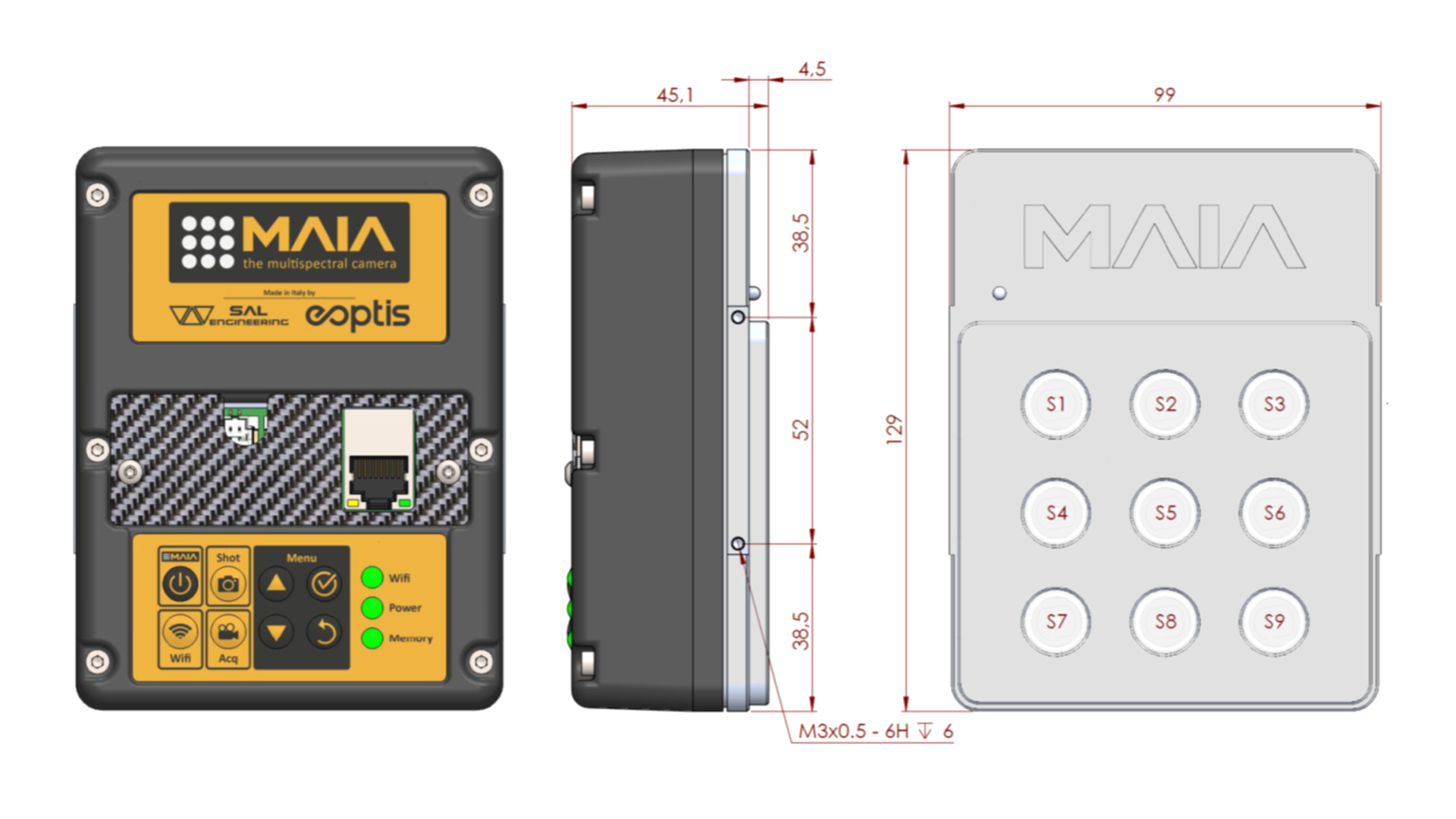
MAIA can interface with various devices that can integrate embedded data into the images:
- GNSS receiver to geotag images
- radio transmitter that send images to the operator and give him feedback about mission and data acquisition
- radio receiver for radio remote control of the camera
- connector for gimbal stabiliser, that takes advantage of the IMU onboard, keeping bearing and orientation
- other devices that need signal at the moment of the shot

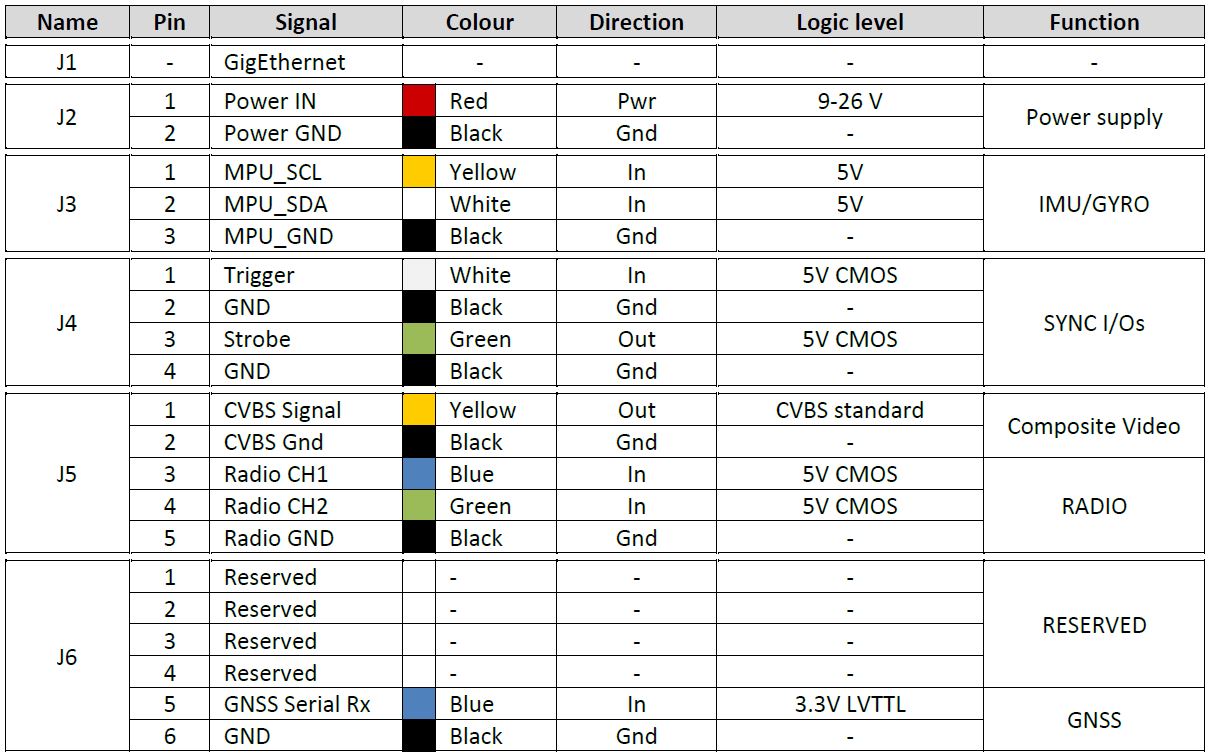
Multispectral imagery
Images are stored in an internal SSD solid memory that is mechanics-free, then it guarantees long term high reliability. Memory capacity can guarantee more than 10000 images. RAW files until 12 bit, that concentrate a large quantity of information, are supported.
Along with the camera, an image processing software will be provided for geometric correction, correction of radial distorsion, coregistration and radiometric correction of the RAW multispectral images acquired with MAIA WV, with tools for indexes calculation and for band combinations.
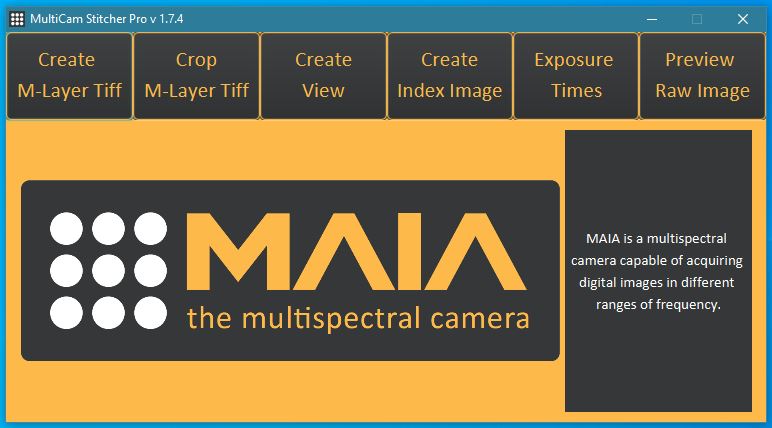
With MAIA - 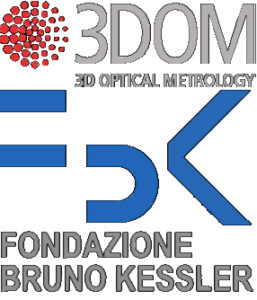 MultiCam Stitcher Pro software, you could create multi-layer tiffs, multichannel tiffs, create view with combination of bands, create index images and preview the raw dataset just acquired.
MultiCam Stitcher Pro software, you could create multi-layer tiffs, multichannel tiffs, create view with combination of bands, create index images and preview the raw dataset just acquired.
You can correct the geometrical distortion of images, get the coregistration pixel-pixel for each band, correct the radiometrical informations within the pixels.
Thanks to this software, you can generate the specific kind of dataset that could be useful for your purpose: photogrammetric processing, single shot analysis, indexes or band combination mapping.
This image processing software of MAIA WV images is jointly developed with the cooperation of 3DOM - 3D Optical Metrology - Fondazione Bruno Kessler (FBK) based in Trento (IT).
Technical features
Sensors | 1 RBG Bayer pattern Sensor 8 CMOS Mono-Chromatic sensors with Bandpass filters Array 3x3 – Centre to centre: 25 mm Resolution: 1.2Mpixel (1280x960) each Type: Global Shutter Pixel size: 3.75 μm x 3.75 μm | ||||||||||||||||||||
Optics | Sensitivity interval VIS-NIR: 390 nm to 950 nm
Lens Fixed focus | ||||||||||||||||||||
Exposure | Type: Manual / Automatic / Automatic based on Max Time Exposure Typical exposure time: 1ms | ||||||||||||||||||||
Acquisition | Type: Single shot / Continuous with external trigger / Continuous at fixed-time interval Max frame rate: 3 frames/sec with RAW 10bit and RAW 12bit; 6 frames/s with RAW 8bit | ||||||||||||||||||||
File format | RAW 8 bit RAW 10 bit RAW 12 bit | ||||||||||||||||||||
Memory | Type: Internal SSD Capacity: 120GB (standard); 250GB; 500GB (on demand) Image size: 21.2 MByte in RAW10 and RAW12 11.8 MByte in RAW8 | ||||||||||||||||||||
Embedded data | Exposure time for each sensor. Timestamp at the shot time. Time, position, speed, fix GNSS. |
